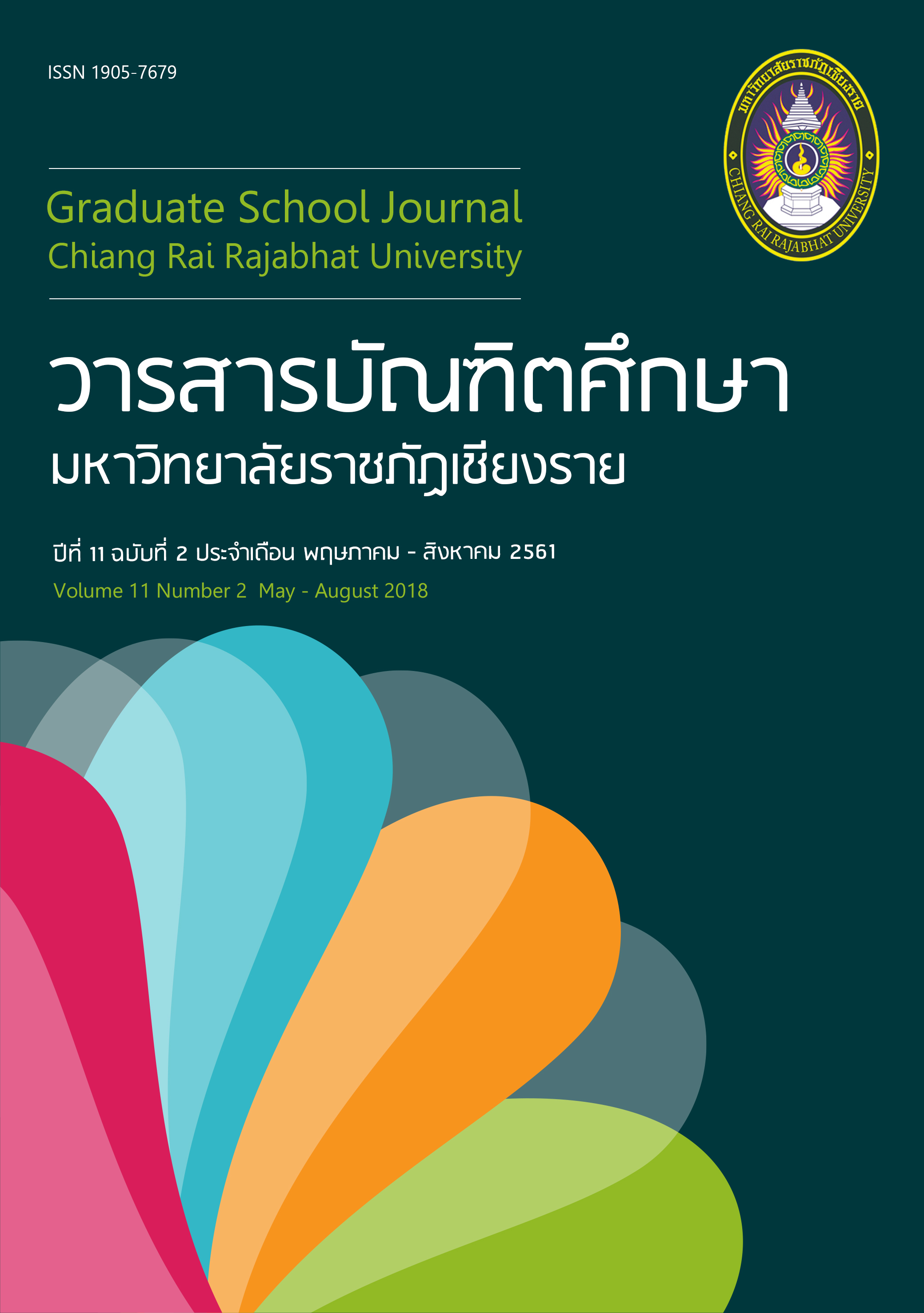A Model of Causal Factors That Influence Deviant Behavior of High School Students in Lampang
Main Article Content
Abstract
The purposes of this research were to investigate the causal relationship model of
factors influencing the deviation behavior of secondary school students in Lampang province,
to study the direct influence indirect and influential effects on deviation behaviors of
Lampang secondary school students. This research is based on the study of the pattern
of causal relationships (Path Analysis) examine the consistency of the model developed
with empirical data and analyze the direct and indirect effects of variables that influence
the deviation behavior of secondary school students in Lampang province by using LISREL
model. The population used in this study were 13 students in Lampang high school in
academic year 2014 using stratifed random sampling. The sample was 369 persons. The
Deviation behavior of secondary school students in Lampang province. Data were analyzed
by using LISREL model. The results were as follows.
1. The analysis of the causal factors that influence deviant behavior of high school
students found that when the offense is a fne model already appeared. The model is
consistent with empirical data. Based on chi – square (x2 = 292.37/296 = 0.98) the
chi-square value was statistically signifcantly different from the zero. The Goodness-of-Fit
Index : GFI = 0.95) Adjusted Adjusted Adjustment Index (Adjusted) AGFI = 0.92), and the
Root Mean Squared Residual (RMR = 0.042) was close to zero (RMSEA = 0.00), not
exceeding 0.05. The standardized residual (SR = 3.09) is greater than 2.00. The standard
scores must be close to 0, and the Q-Plot has less slope than the diagonal. When the
graph slopes near the diagonal line, the predictive coeffcient or R-Square variable in the
model explained the variance of the self-cognitive ability of the students was 88.00 percent.
2. Influence model is the most influential social variables, as well as a large quantity
of 0.92, followed by the variable personalization features and variables that influence the
amount of 0.66 minimum per student variable deviant behavior. Education is a variable
quantity -0.33.
3. The direct influence of the model was the direct influence of the social variable
0.92, followed by the media and technology variables of 1.60, and the least influential
variables on the behavioral variance. The friend variable is -1.60.
4. The indirect effect in the model is the total influence of the variables of the
study, passing through the variables of the person’s characteristics is 0.68, followed by the
variables of friends passing through the variables of the learner’s characteristics is 1.66,
and the variables have the least influence on students’ deviant behavior variables is a
media and technology variable by passing the variable, the student’s attribute value is
-1.65.
Article Details
บทความที่ได้รับการตีพิมพ์เป็นลิขสิทธิ์ของวารสารมหาวิทยาลัยราชภัฎเชียงราย
ข้อความที่ปรากฏในบทความแต่ละเรื่องในวารสารวิชาการเล่มนี้เป็นความคิดเห็นส่วนตัวของผู้เขียนแต่ละท่านไม่เกี่ยวข้องกับมหาวิทยาลัยราชภัฎเชียงราย และคณาจารย์ท่านอื่นๆในมหาวิทยาลัยฯ แต่อย่างใด ความรับผิดชอบองค์ประกอบทั้งหมดของบทความแต่ละเรื่องเป็นของผู้เขียนแต่ละท่าน หากมีความผิดพลาดใดๆ ผู้เขียนแต่ละท่านจะรับผิดชอบบทความของตนเองแต่ผู้เดียว
References
ปี 2550 : ภาคเหนือตอนบน (เชียงราย เชียงใหม่ พะเยา แพร่ น่าน แม่ฮ่องสอน ลำปาง และ
ลำพูน). กรุงเทพฯ: สำนักงานกองทุนสนับสนุนการวิจัย.
นงลักษณ์ วิรัชชัย. (2542). โมเดลลิสเรล สถิติวิเคราะห์สำหรับการวิจัย. (พิมพ์ครั้งที่ 3). กรุงเทพฯ:
โรงพิมพ์แห่งจุฬาลงกรณ์มหาวิทยาลัย.
นิตยา กัทลีรดะพันธุ์. (2541). วิเคราะห์การใช้สารเสพติดในระบบข้อมูลเยาวชน สถานพินิจและ
คุ้มครองเด็ก และเยาวชน กรุงเทพมหานคร. (พิมพ์ครั้งที่ 2). กรุงเทพฯ: จุฬาลงกรณ์
มหาวิทยาลัย.
ศูนย์เฝ้าระวังทางวัฒนธรรม. (2553). คู่มือเฝ้าระวังทางวัฒนธรรมสำหรับเด็กและเยาวชน. กรุงเทพฯ:
ศูนย์ฯ.
Sutherland. (1947). Crimnology. Philadelphia: J.B. Lippincott.
สำนักงานวัฒนธรรมจังหวัดนครนายก. (2554). การเบี่ยงเบนพฤติกรรมของวัยรุ่น จังหวัดนครนายก
ประจำปี 2554. นครนายก. สำนักวัฒนธรรมฯ.

